The Effect of P2O5 Fertilizer, Zeolite, and Volcanic Soil Media from Different Altitudes on the Soil Mineral, Growth, Yield, and Asiaticoside Content of Centella asiatica L.
Abstract
:1. Introduction
2. Materials and Methods
2.1. Study and Soil Collection Site
2.2. Experimental Design
- Factor 1: volcanic soil media from 3 different locations on the hilly of Merapi:
- A1: Inceptisol from Kalitirto (representing an altitude of 100 m asl).
- A2: Inceptisol from Wukirsari (representing an altitude of 450 m asl).
- A3: Inceptisol from Hargobinangun (representing an altitude of 900 m asl).
- Factor 2: The dose of inorganic P2O5 fertilizer with 4 levels:
- P0: P2O5 fertilizer with a dose of 0 kg ha−1.
- P1: P2O5 fertilizer with a dose of 27 kg ha−1 or the equivalent of 0.15 g 10 kg−1 of soil.
- P2: P2O5 fertilizer with a dose of 54 kg ha−1 or the equivalent of 0.30 g 10 kg−1 of soil.
- P3: P2O5 fertilizer with a dose of 81 kg ha−1 or the equivalent of 0.45 g 10 kg−1 of soil.
- Factor 3: The dose of zeolite mineral application with 3 levels:
- Z0: Without zeolite (0 t ha−1 of zeolite).
- Z3: Zeolite mineral application 3 t ha−1 or equivalent to 6 g 10 kg−1 of soil.
- Z6: Zeolite mineral application 6 t ha−1 or equivalent to 12 g 10 kg−1 of soil.
2.3. The Mineralogy and Soil Analysis
2.4. Statistical Analysis
3. Results
3.1. Characteristic of Soil Minerals and Soil Properties of Volcanic Soil Media
3.2. The Effect of Volcanic Soil Media, P2O5 Fertilizer, and Zeolite Minerals on C. asiatica Growth
3.3. The P and K Nutrient Uptake of C. asiatica
3.4. Asiaticoside Content of C. asiatica
3.5. The Dry Weight of Plant and Asiaticoside Content of C. asiatica
3.6. The Correlation of Plant-Growth Components and Nutrient Uptake of the Asiaticoside Content
4. Discussion
4.1. Environmental Condition
4.2. Performance Growth and Productivity of C. asiatica
4.3. The effect of Volcanic Soil Media, P2O5 fertilizer, and Zeolite Minerals on Nutrient Uptake and Asiaticoside Content
4.4. Correlation of Plant Growth and Nutrient Uptake of the Asiaticoside Content
5. Conclusions
Author Contributions
Funding
Institutional Review Board Statement
Informed Consent Statement
Data Availability Statement
Acknowledgments
Conflicts of Interest
References
- Hamid, I.S.; Widjaja, N.M.R.; Damayanti, R. Anticancer Activity of Centella asiatica Leaves Extract in Benzo(a)pyrene-Induced Mice. Int. J. Pharmacogn. Phytochem. Res. 2016, 8, 80–84. [Google Scholar]
- Kimit, O.T.; Kim, M.Y.; Huh, S.M.; Ahn, J.C.; Seong, N.S. Effect of Growth Regulators on Asiaticoside Production in Whole. J. Plant Biol. 2007, 47, 361–365. [Google Scholar]
- Park, J.H.; Choi, J.Y.; Son, D.J.; Park, E.K.; Song, M.J.; Hellström, M.; Hong, J.T. Anti-inflammatory effect of titrated extract of Centella asiaticain phthalic anhydride-induced allergic dermatitis animal model. Int. J. Mol. Sci. 2017, 18, 738. [Google Scholar] [CrossRef]
- Arribas-López, E.; Zand, N.; Ojo, O.; Snowden, M.J.; Kochhar, T. A systematic review of the effect of Centella asiatica on wound healing. Int. J. Environ. Res. Public Health 2022, 19, 3266. [Google Scholar] [CrossRef]
- Zhang, L.; Lu, H.Z.; Gong, X. Protective effects of Asiaticoside on acute liver injury induced by lipopolysaccharide/D-galactosamine in mice. Phytomedicines 2010, 17, 811–819. [Google Scholar] [CrossRef] [PubMed]
- Shukurova, M.K.; Myint, D.; Yi, S.S.; Saw, O.M.; Watanabe, K.N. Morphological Description and Ethnobotanical Review of the Orphan Crop Myin-Hkwa (Centella asiatica L.) From Myanmar. Front. Sustain. Food Syst. 2021, 5, 680862. [Google Scholar] [CrossRef]
- Puttarak, P.; Panichayupakaranant, P. Factors affecting the content of pentacyclic triterpenes in Centella asiatica raw materials. Pharm. Biol. J. 2012, 50, 1508–1512. [Google Scholar] [CrossRef]
- Ogunka-Nnoka, C.U.; Igwe, F.U.; Agwu, J.; Peter, O.J.; Wolugbom, P.H. Nutrient and Phytochemical Composition of Centella asiatica Leaves. Med. Aromat. Plants 2020, 9, 1–7. [Google Scholar]
- Kunle, O.F.; Egharevba, H.O.; Ahmadu, P.O. Standardization of herbal medicines—A review. Int. J. Biodivers. Conserv. 2012, 4, 101–112. [Google Scholar] [CrossRef]
- Kurniawan, T.; Nuryoto, N.; Firdaus, M.A. Zeolite for agriculture intensification and catalyst in Agroindustry. World Chem. Eng. J. 2019, 3, 13–23. [Google Scholar]
- Cataldo, E.; Salvi, L.; Paoli, F.; Fucile, M.; Masciandaro, G.; Manzi, D.; Masini, C.M.; Mattii, G.B. Application of zeolites in agriculture and other potential uses: A review. Agronomy 2021, 11, 1547. [Google Scholar] [CrossRef]
- Pisarovic, A.; Filipan, T.; Tisma, S. Application of zeolite based special substrates in agriculture: Ecological and economical justification. Period. Biol. 2003, 105, 287–293. [Google Scholar]
- Mumpton, F.A. Utilization of Natural Zeolites. In Chapter 9. Mineralogy and Geology of Natural Zeolites; Mumpton, F.A., Ed.; De Gruyter: Berlin, Boston, 2018; pp. 177–206. [Google Scholar]
- Sepaskhah, A.R.; Yousefi, F. Effects of zeolite application on nitrate and ammonium retention of loamy soil under saturated conditions. Aust. J. Soil Res. 2007, 45, 368–373. [Google Scholar] [CrossRef]
- Santosa, L.W. Identification of Land Degradation and Method of Solution in Zone of Baturagung Hill at Gunungkidul Regency. Forum Geogr. 2005, 19, 30–54. [Google Scholar] [CrossRef] [Green Version]
- Anda, M.; Sarwani, M. Mineralogy, chemical composition, and dissolution of fresh ash eruption: New potential source of nutrients. Soil Sci. Soc. Am. J. 2012, 76, 733–747. [Google Scholar] [CrossRef]
- Afany, M.R.; Partoyo. Characteristics of Fresh Volcanic Ash of Mount Merapi Yogyakarta. J. Tanah Dan Air 2001, 2, 88–96. [Google Scholar]
- Aini, L.N.; Mulyono; Hanudin, E. Easily Weathered Minerals Pyroclastic Materials of Merapi and Potential Nutrients for Plants. Planta Trop. J. Agro Sci. 2016, 4, 85–94. [Google Scholar]
- Huang, P.M. Felspars, olivine, Pyroxenes, and amphiboles. In Minerals in Soil Environments; Dixon, J.B., Weed, S.B., Eds.; Soil Science Society of America: Madison, WI, USA, 1989; pp. 945–1050. [Google Scholar]
- Suriadikusumah, A.; Nugraha, W.; Nurlaeny, N.; Devnita, R. Effect of Different Mixed Media (Merapi Volcanic Ash, Cow Manure and Mineral Soil) on Chemical Properties of Soil and Growth of Maize (Zea mays L.). J. Agric. Sci. 2012, 5, 188–196. [Google Scholar] [CrossRef]
- Wahyudi, A.; Wahyudi, T. A Literature Study of Benefiting K-bearing Silicate Rocks as Raw Materials for Potassium Fertilizer. Indones. Min. J. 2013, 16, 101–110. [Google Scholar]
- Research Center for Soil and Agroclimate. Survey and Mapping of Land Resources for Agricultural Development, Land Rehabilitation, and Soil Conservation in the Special Region of Yogyakarta, Scale 1:50.000; Land Resources Research Project: Bogor, Indonesia, 1994. [Google Scholar]
- Gunawan, E. Determination of Phosphorus and Potassium Fertilization Recommendations Based on Soil Tests for Tomato Plants (Solanum lycopersicum L.) on Andisol Soil. Ph.D. Thesis, Bogor Institute of Agriculture, Bogor, Indonesia, 2020. [Google Scholar]
- Indonesian Soil Research Institute. Technical Instructions for Chemical Analysis of Soil, Plants, Water, and Fertilizers; Indonesian Soil Research Institute; Indonesian Agency for Agriculture Research and Development, Ministry of Agriculture: Bogor, Indonesia, 2009. [Google Scholar]
- Noertjahyani, N.; Sondari, N. Effect of Zeolite Dosage on Growth of Cadmium Levels and Yield of Lettuce (Lactuca sativa L.) on Cadmium Heavy Metal Stress. J. Zeolit Indones. 2009, 8, 76–82. [Google Scholar]
- Agus, F.; Yusrial, F.; Sutono, S. Determination of Soil Texture. In Soil Physical Properties and Analytical Methods; Kurnia, U., Agus, F., Adimihardja, A., Dariah, A., Eds.; Soil Research Institute, Indonesian Center for Agricultural Land Resources Research and Development: Bogor, Indonesia, 2006; pp. 43–62. [Google Scholar]
- Sulaeman; Suparto; Eviati. Technical Instructions for Chemical Analysis of Soil, Water and Fertilizer; Soil Research Institute, Indonesian Center for Agricultural Land Resources Research and Development: Bogor, Indonesia, 2005; p. 143. [Google Scholar]
- Idrus, A.; Titisan, A.D.; Warmada, I.W.; Setijadji, L.D.; Hakim, F.; Aldan, F.A.; Widihermawan, A.C. Guidelines for Geological Analysis of Mineral Resources; Gadjah Mada University Press: Yogyakarta, Indonesia, 2021; p. 186. [Google Scholar]
- Hussin, M.; Hamid, A.A.; Mohamad, S.; Saari, N.; Ismail, M.; Bejo, M.H. Protective effect of Centella asiatica extract and powder on oxidative stress. Sci. Direct 2007, 100, 535–541. [Google Scholar] [CrossRef]
- Gomez, K.A.; Gomez, A.A. Statistical Procedures for Agricultural Research, 2nd ed.; John Wiley and Sons: New York, NY, USA, 1984; p. 680. [Google Scholar]
- Devkota, A.; Kumar, J.P. Variation in Growth of Centella asiatica along Different Soil Composition. Bot. Res. Int. 2009, 2, 55–60. [Google Scholar]
- Fawzia, A.A.; Wiradiputra, R.A. Testing of Rain Data at Rain Stations includes Prumpung Station, Dolo Station, Jangkang Station and Gondangan Station on the Slope of Merapi Volcano, Yogyakarta Special Region. J. Meteorol. Klimatol. Dan Geofis. 2015, 2, 66–72. [Google Scholar]
- Halimi, E.S. Identification of Agronomic Traits of Centella asiatica Naturally Grown at Regions with Different Altitude. J. Nat. Indones. 2011, 13, 232–236. [Google Scholar] [CrossRef] [Green Version]
- Sutardi. Study of Different Harvest Time and Phosphorus (P2O5) Fertilization in Upland Andisols Soil on Asiaticoside Content of Centella asiatica. Master’s Thesis, Bogor Institute of Agriculture, Bogor, Indonesia, 2008. [Google Scholar]
- Vinolina, N.S. The Increase in Centelloside Production of Pegagan (Centella asiatica) through Application of Phosphorus and Methyl Jasmonate with Different Harvest Time. Ph.D. Thesis, Universitas Sumatera Utara, Medan, Indonesia, 2014. [Google Scholar]
- Dahono, D.; Ghulamahdi, M.; Aziz, S.A.; Adiwirman, A. Combination NPK Fertilizer and Manure Application to Increase Growth and Asiaticoside Production of Indian Pennyworth. Jurna Penel. Tan. Ind. 2011, 17, 51–59. [Google Scholar]
- Ghulamahdi, M.; Aziz, S.A.; Bermawie, N.; Hernani. Evaluation of Centella asiatica based on its morphological, physiological and gentics appearances to support quality standardization of Centella asiatica. In Research Report, Cooperation Partnership between Bogor Institute of Agriculture and Indonesian Agency for Agricultural Research and Development; Indonesian Agency for Agricultural Research and Development: South Jakarta, Indonesia, 2007; p. 99, (Unpublished). [Google Scholar]
- Mulugeta, D.; Sheleme, B. Characterization and Classification of Soil Along the Toposequence of Kindo Koye Watershed in Southern Ethiopia. East Afr. J. Sci. 2010, 4, 65–77. [Google Scholar] [CrossRef] [Green Version]
- Sari, M.; Napitupulu, J.A.; Lahay, R.R. The Effect of Phosphor Application and Harvesting Time to Growth and Production of Centella asiatica L. Urban. J. Agroteknologi 2013, 2, 244–252. [Google Scholar]
- Santoso, G. Effect of Harvest Time and Phosphorus Fertilization on The Growth and Production of Centella asiatica L. Urban. Bachelor’s Thesis, Bogor Institute of Agriculture, Bogor, Indonesia, 2008. [Google Scholar]
- Vinolina, N.S. Centelloside content of cultivated pegagan (Centella asiatica) with application of phosporus fertilizer. IOP Conf. Ser. J. Phys. Conf. Ser. 2018, 1116, 052072. [Google Scholar] [CrossRef]
- Musyarofah, N.; Susanto, S.; Aziz, S.A.; Kartosoewarno, S. Respons of Centella asiatica L. (Urban) Plant to Natural Fertilizers Under Shade Condition. Bul. Agron 2007, 35, 217–224. [Google Scholar]
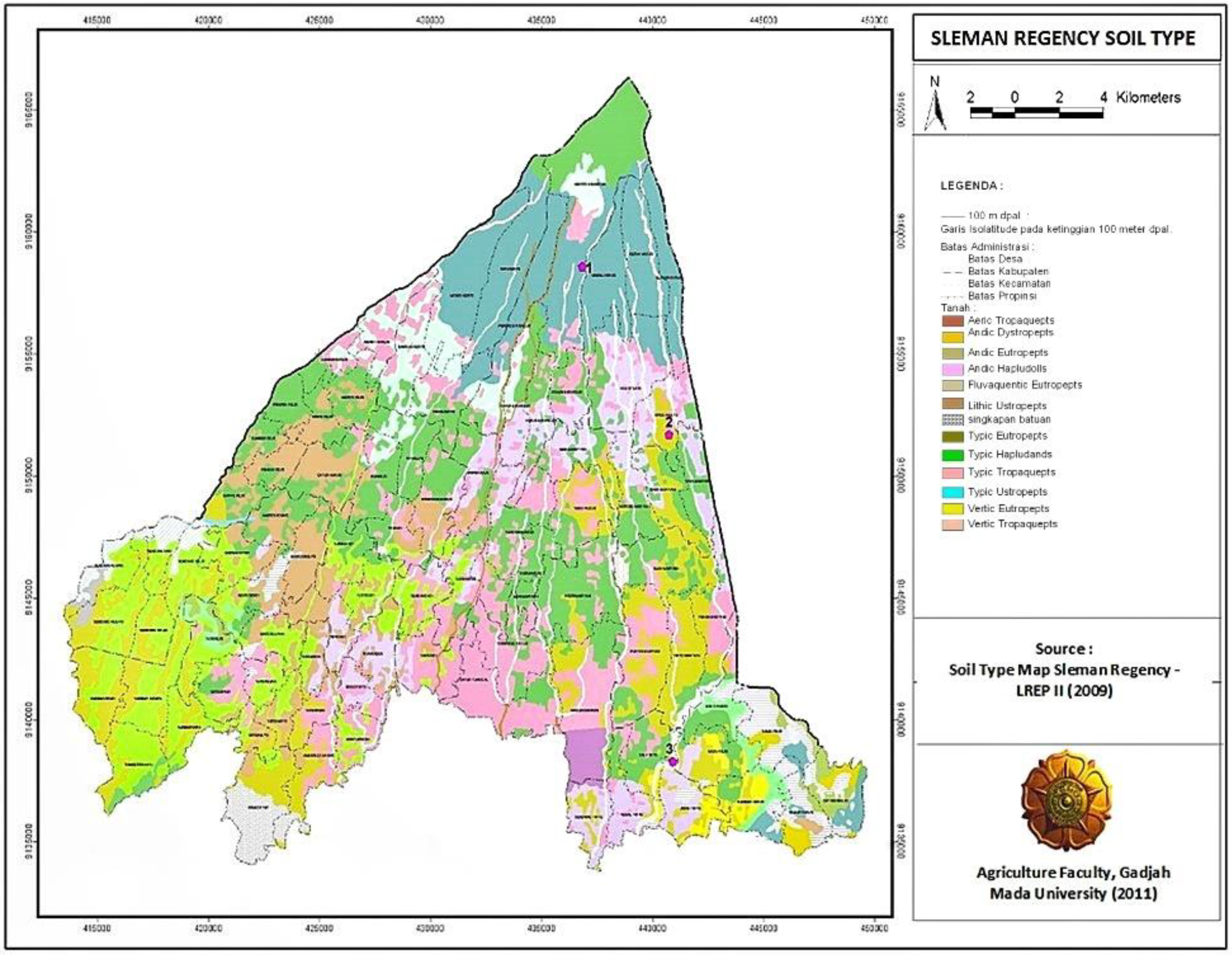
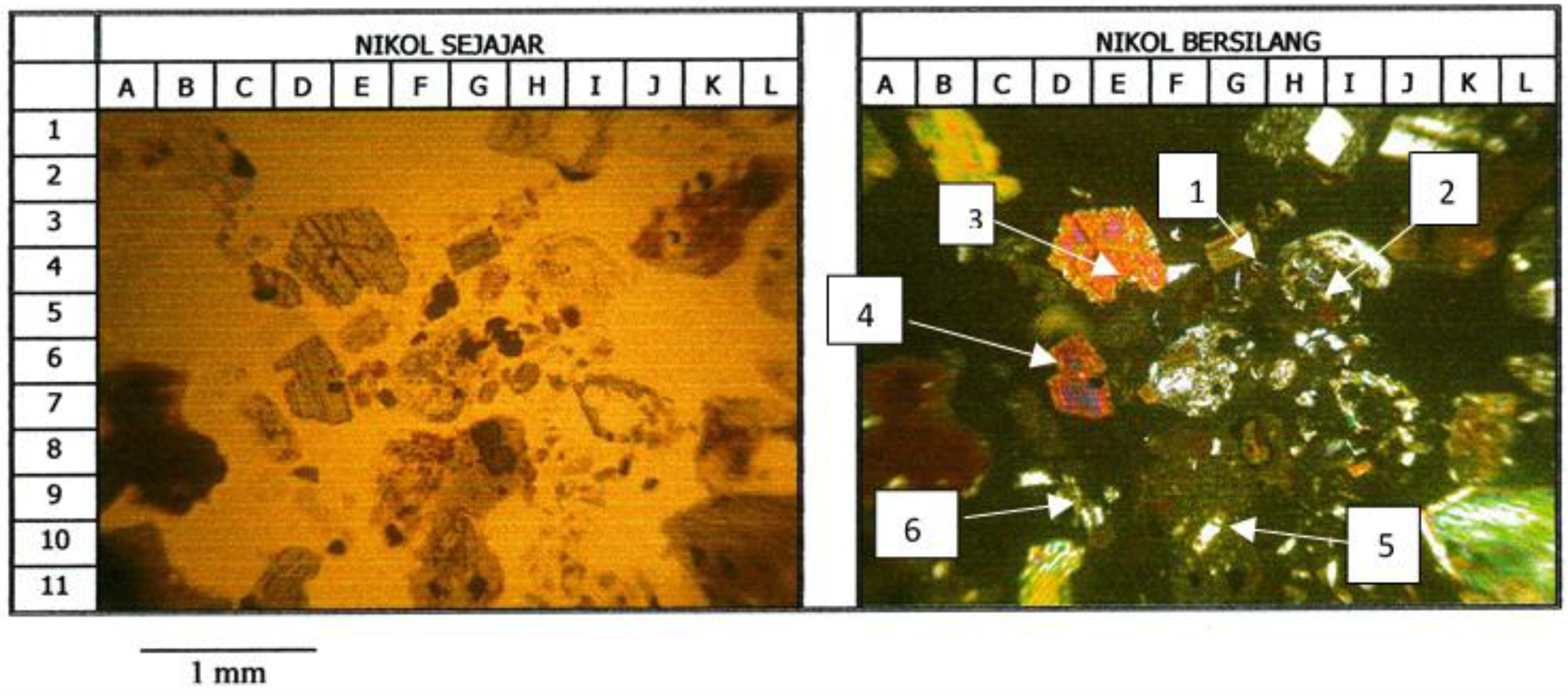
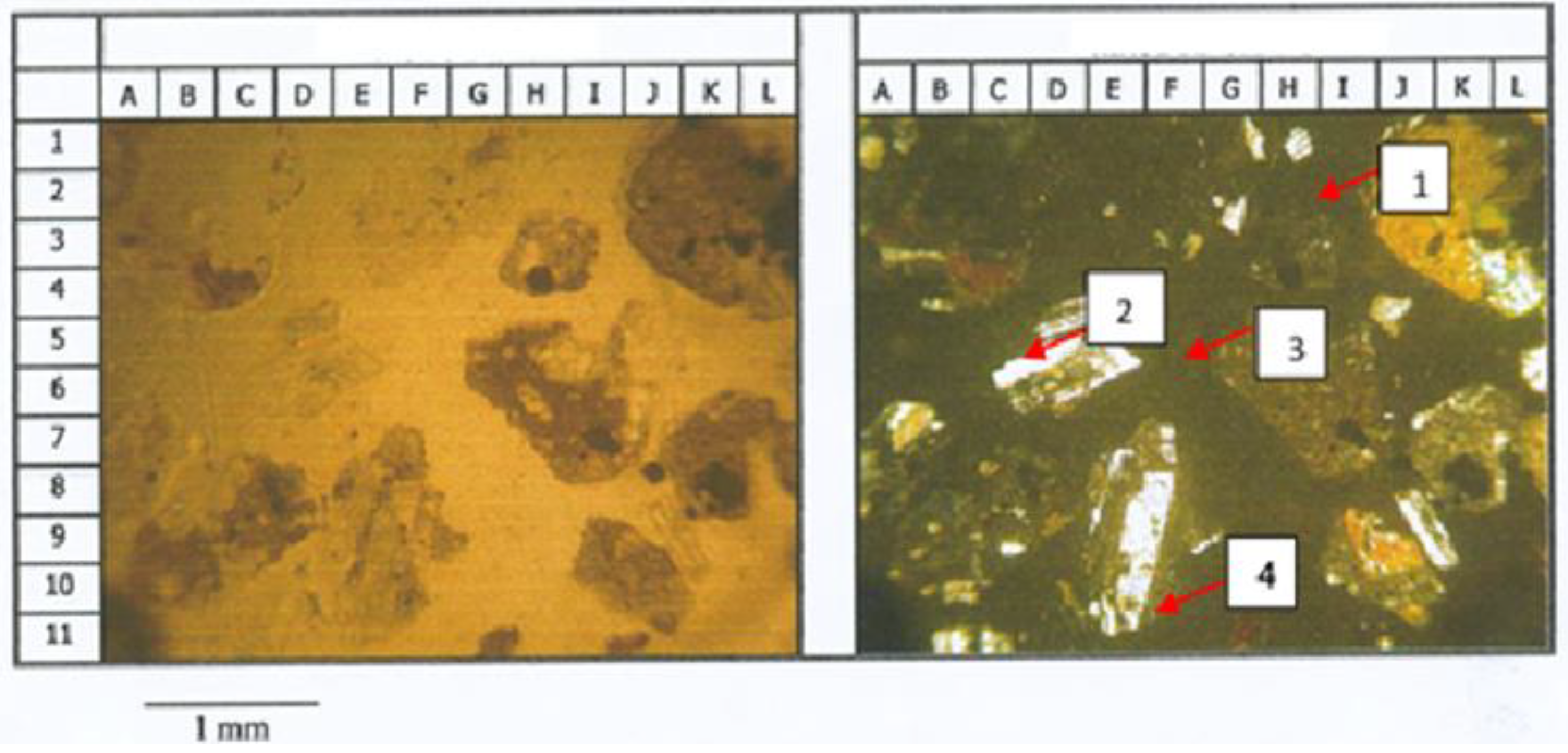

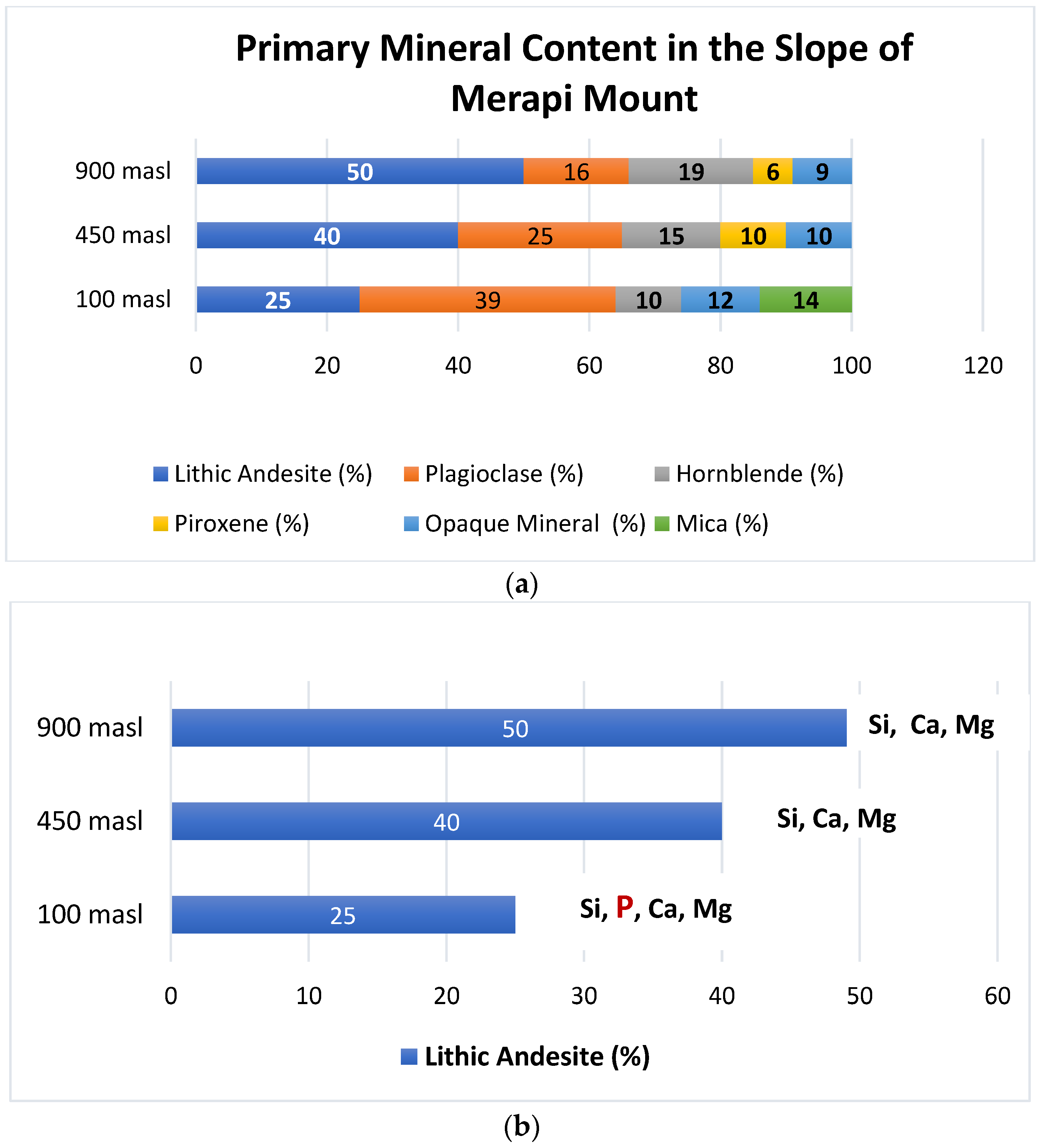
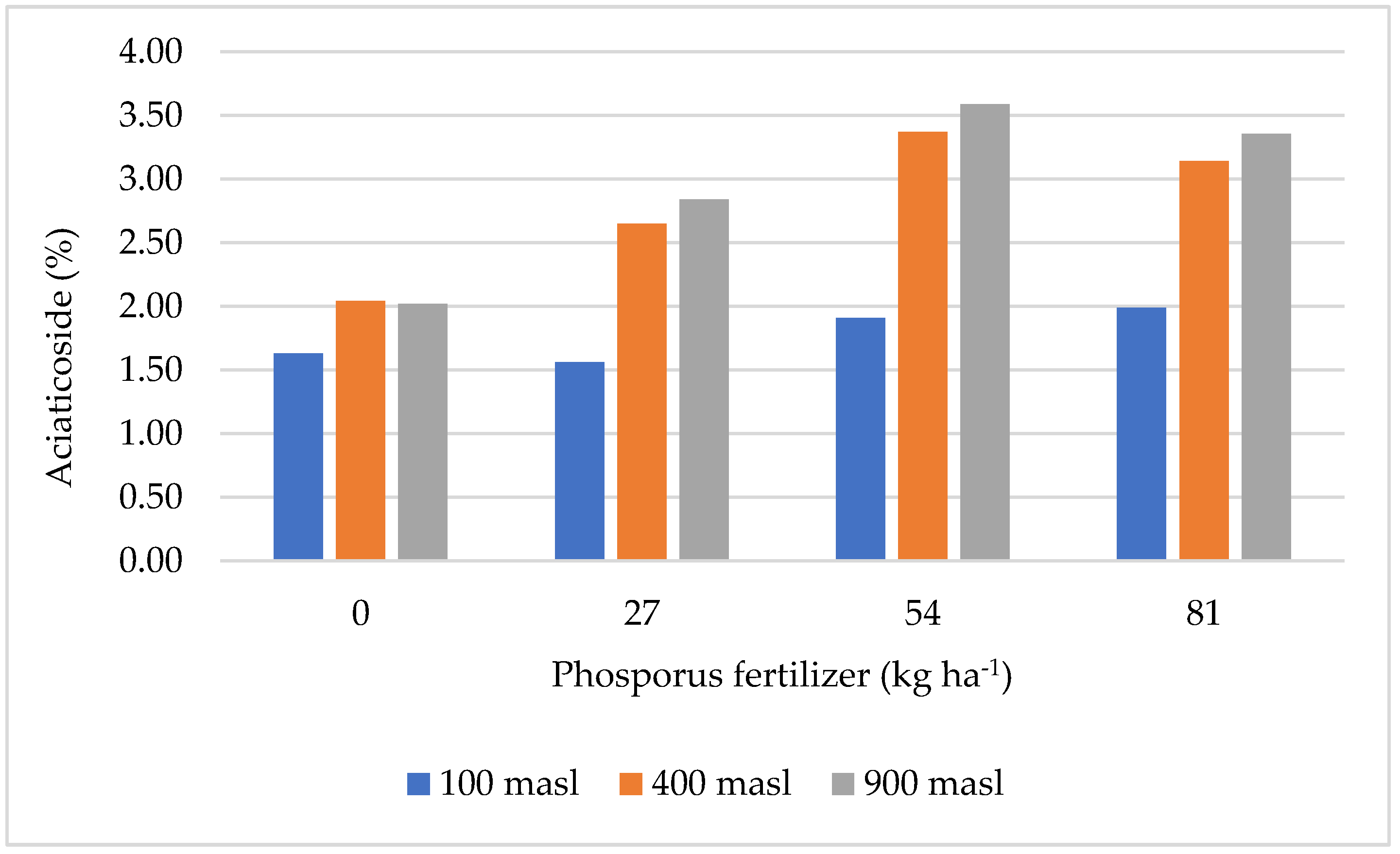
| Altitude (m asl) | Soil Particles | Soil Texture Class | PD | BD | ||
|---|---|---|---|---|---|---|
| (g cm−3) | ||||||
| Clay (%) | Silt (%) | Sand (%) | ||||
| 100 | 9.72 ± 0.58 | 25.38 ± 1.54 | 64.90 ± 0.89 | Sandy loam | 2.56 ± 0.08 | 1.25 ± 0.04 |
| 450 | 12.10 ± 1.2 | 28.97 ± 1.52 | 58.93 ± 1.50 | Sandy loam | 2.42 ± 0.02 | 0.95 ± 0.06 |
| 900 | 2.51 ± 0.08 | 11.29 ± 0.68 | 86.20 ± 0.61 | Loamy sand | 2.51 ± 0.02 | 0.93 ± 0.08 |
| Altitude (m asl) | Soil Depth (cm) | Soil pH | C-Org. | Base Cation | N Total | C/N | K Avail. | P Avail (Olsen) | Pot. P | CEC | |||
|---|---|---|---|---|---|---|---|---|---|---|---|---|---|
| H2O | KCl | NaF | Ca | Mg | % | cmol kg−1 | µg g−1 | mg kg−1 | cmol kg−1 | ||||
| % | cmol kg−1 | ||||||||||||
| 100 | 0–21 | 6.34 (SA) | 5.88 (N) | 9.43 | 1.15 (L) | 11.46 (H) | 2.83 (H) | 0.14 (L) | 8.21 (L) | 0.95 (H) | 35.85 (H) | 92.06 (VH) | 10.94 (L) |
| 450 | 0–24 | 6.12 (SA) | 5.63 (N) | 10.89 | 2.52 (M) | 8.06 (M) | 1.79 (M) | 0.19 (L) | 13.26 (H) | 0.26 (L) | 26.42 (M) | 185.84 (VH) | 15.45 (L) |
| 900 | 0–22 | 5.18 (A) | 5.43 (N) | 11.48 | 3.16 (H) | 2.76 (L) | 0.49 (L) | 0.25 (M) | 12.64 (M) | 0.34 (L) | 16.06 (L) | 272.93 (VH) | 22.43 (M) |
| Observation Data | Soil Altitude | P2O5 Fertilizer | Zeolite Mineral | A × P | A × Z | P × Z | A × P × Z |
|---|---|---|---|---|---|---|---|
| The number of leaves | ** | ** | * | * | ns | ns | ns |
| Root dry weight | ** | ** | * | ** | ns | ns | ns |
| Biomass Plant weight | ** | ** | ** | ** | ns | ns | ns |
| The Length of roots | ** | ** | * | ** | ns | ns | ns |
| Ca2 ± nutrient content | ** | ** | ** | ** | ns | ns | ns |
| Mg2 ± nutrient content | ** | * | ** | * | ns | ns | ns |
| P Uptake on plant | ** | ** | ** | ** | ns | ns | ns |
| K Uptake on plant | ** | * | ** | ** | ns | ns | ns |
| P Available | ** | * | ns | ns | ns | ns | ns |
| K Available | * | ** | ns | ns | ns | ns | ns |
| Plant dry weight | ** | ** | ** | ** | ns | ns | ns |
| Asiaticoside content | ** | ** | ** | ** | ns | ns | ns |
| Treatments Code | The Number of Leaves | The Root Dry Weight (g) | Length of the Roots (cm) | Plant Wet Weight (g) | Plant Dry Weight (g) |
|---|---|---|---|---|---|
| A1P0 | 78.85 ± 1.1 f | 2.43 ± 0.18 bc | 31.25 ± 1.37 e | 85.32 ±1.71 f | 12.43 ± 0.95 e |
| A1P1 | 79.14 ± 0.85 f | 2.38± 0.1 bc | 36.73 ± 0.95 b | 90.67 ± 0.67 f | 12.16 ± 1.44 e |
| A1P2 | 83.42 ± 0.68 ef | 2.26 ± 0.13 bc | 36.07 ± 0.39 bc | 99.47 ± 0.73 ef | 15.23 ± 1.13 c |
| A1P3 | 89.73 ± 1.04 de | 2.5 ± 0.12 b | 36.17 ± 0.28 bc | 117.52 ± 0.87 d | 14.82 ± 0.99 c |
| A2P0 | 79.53 ± 0.91 f | 2.46 ± 0.14 bc | 35.44 ± 0.26 bc | 135.64 ± 1.56 c | 15.97 ± 0.94 bc |
| A2P1 | 78.11 ± 0.77 f | 2.86 ± 0.09 ab | 37.25 ± 0.86 ab | 165.07 ± 1.06 b | 16.94 ± 0.84 b |
| A2P2 | 95.23 ± 1.52 d | 3.47 ± 0.17 a | 38.72 ± 1.02 a | 170.68 ± 1.31 a | 19.87 ± 0.86 a |
| A2P3 | 90.55 ± 0.91 de | 3.28 ± 0.08 a | 34.03 ± 1.0 c | 174.16 ± 1.36 a | 16.64 ± 1.01 c |
| A3P0 | 113.2 ± 1.76 b | 2.53 ± 0.06 b | 31.57 ± 0.84 de | 110.96 ± 1.46 de | 13.86 ± 0.56 d |
| A3P1 | 104.11 ± 3.27 c | 2.62 ± 0.1 b | 36.48 ± 0.72 b | 113.64 ± 0.95 d | 13.04 ± 1.49 de |
| A3P2 | 120.88 ± 1.09 a | 3.10 ± 0.12 a | 38.58 ± 0.97 a | 168.76 ± 1.47 ab | 19.24 ± 1.16 a |
| A3P3 | 110.44 ± 1.58 bc | 2.02 ± 0.13 c | 34.18 ± 1.29 c | 143.75 ± 0.96 bc | 15.58 ± 0.03 c |
| CV (%) | 10.12 | 9.65 | 9.72 | 10.68 | 10.72 |
| Treatments Code | Ca2+ Nutrient | Mg2 Nutrient | P Nutrient Uptake | K Nutrient Uptake | P nutrient Available | Asiaticoside Content |
|---|---|---|---|---|---|---|
| (cmol kg−1) | (cmol kg−1) | (g·tan−1) | (g·tan−1) | (µg g−1) | (% Dry Weight) | |
| A1P0 | 9.48 ± 0.12 c | 2.52 ± 0.06 d | 0.387 ± 0.05 f | 0.469 ± 0.05 d | 29.62 ± 0.84 d | 1.63 ±0.10 e |
| A1P1 | 9.93 ± 0.48 c | 2.47 ± 0.07 d | 0.405 ± 0.03 e | 0.482 ± 0.09 c | 31.57 ± 0.64 d | 1.56 ± 0.06 e |
| A1P2 | 10.78 ± 0.15 d | 2.86 ± 0.12 d | 0.551 ± 0.07 cd | 0.698 ± 0.07 a | 37.93 ± 0.48 e | 1.89 ± 0.10 de |
| A1P3 | 10.65 ± 0.09 d | 2.91 ± 0.07 d | 0.514 ± 0.04 d | 0.607 ± 0.06 ab | 38.53 ± 0.88 e | 1.99 ± 0.12 d |
| A2P0 | 7.29 ± 0.13 b | 1.66 ± 0.07 b | 0.488 ± 0.04 de | 0.541 ± 0.06 bc | 21.36 ± 0.77 c | 2.04 ± 0.13 bc |
| A2P1 | 7.48 ± 0.12 b | 1.53 ± 0.08 a | 0.578 ± 0.03 c | 0.577 ± 0.07 b | 24.38 ± 0.93 cd | 2.68 ± 0.12 c |
| A2P2 | 8.15 ± 0.1 bc | 1.79 ± 0.2 c | 0.793 ± 0.08 a | 0.572 ± 0.09 b | 28.45 ± 0.85 d | 3.37 ± 0.07 ab |
| A2P3 | 7.94 ± 0.37 b | 1.73 ± 0.1 bc | 0.692 ± 0.05 b | 0.614 ± 0.06 ab | 30.18 ± 0.90 d | 3.14 ± 0.13 b |
| A3P0 | 2.57 ± 0.15 a | 0.49 ± 0.06 a | 0.419 ± 0.04 e | 0.489 ± 0.04 c | 10.74 ± 0.57 a | 2.03 ± 0.17 d |
| A3P1 | 2.29 ± 0.09 a | 0.46 ± 0.04 a | 0.518 ± 0.07 d | 0.546 ± 0.09 bc | 13.81 ± 1.35 ab | 2.85 ± 0.09 c |
| A3P2 | 2.83 ± 0.07 a | 0.59 ± 0.05 ab | 0.702 ± 0.05 b | 0.590 ± 0.04 b | 16.67 ± 0.69 b | 3.61 ± 0.18 a |
| A3P3 | 2.72 ± 0.09 a | 0.53 ± 0.07 a | 0.687 ± 0.04 b | 0.505 ± 0.03 bc | 17.92 ± 0.49 b | 3.36 ± 0.09 ab |
| CV (%) | 11.47 | 10.32 | 9.98 | 11.24 | 10.73 | 11.43 |
| Dose of Zeolite (t ha−1) | Plant Dry Weight (g) | Nutrients Uptake (g plant−1) | Ca 2+ Mg 2+ Nutrient Content (cmol kg−1) | Asiaticoside Content (%) | ||
|---|---|---|---|---|---|---|
| P | K | |||||
| 0.0 | 13.49 b | 0.516 b | 0.622 c | 5.48 b | 1.43 b | 1.15 b |
| 3.0 | 16.72 a | 0.823 a | 0.968 a | 8.64 a | 2.37 a | 3.28 a |
| 6.0 | 16.47 a | 0.804 a | 0.795 b | 8.29 a | 2.58 a | 3.32 a |
| Variables | Correlation of the Asiaticoside Content on the Different Altitude (r) | ||
|---|---|---|---|
| 900 | 450 | 100 | |
| m asl | |||
| The number of leaves | 0.516 * | 0.497 * | 0.435 |
| Plant dry weight (g) | 0.779 ** | 0.505 | 0.318 |
| P nutrient uptake (kg ha−1) | 0.878 ** | 0.656 * | 0.587 * |
| K nutrient uptake (kg ha−1) | 0.238 | 0.349 | 0.559 * |
| C-organic content of plant (%) | 0.623 ** | 0.509 * | 0.478 * |
Publisher’s Note: MDPI stays neutral with regard to jurisdictional claims in published maps and institutional affiliations. |
© 2022 by the authors. Licensee MDPI, Basel, Switzerland. This article is an open access article distributed under the terms and conditions of the Creative Commons Attribution (CC BY) license (https://creativecommons.org/licenses/by/4.0/).
Share and Cite
Riyanto, D.; Dianawati, M.; Sutardi; Susanto, H.; Sasongko, N.A.; Sri Ratmini, N.P.; Rejekiningrum, P.; Yustisia; Susilawati, H.L.; Hanafi, H.; et al. The Effect of P2O5 Fertilizer, Zeolite, and Volcanic Soil Media from Different Altitudes on the Soil Mineral, Growth, Yield, and Asiaticoside Content of Centella asiatica L. Sustainability 2022, 14, 15394. https://doi.org/10.3390/su142215394
Riyanto D, Dianawati M, Sutardi, Susanto H, Sasongko NA, Sri Ratmini NP, Rejekiningrum P, Yustisia, Susilawati HL, Hanafi H, et al. The Effect of P2O5 Fertilizer, Zeolite, and Volcanic Soil Media from Different Altitudes on the Soil Mineral, Growth, Yield, and Asiaticoside Content of Centella asiatica L. Sustainability. 2022; 14(22):15394. https://doi.org/10.3390/su142215394
Chicago/Turabian StyleRiyanto, Damasus, Meksy Dianawati, Sutardi, Heru Susanto, Nugroho Adi Sasongko, Niluh Putu Sri Ratmini, Popi Rejekiningrum, Yustisia, Helena Lina Susilawati, Hano Hanafi, and et al. 2022. "The Effect of P2O5 Fertilizer, Zeolite, and Volcanic Soil Media from Different Altitudes on the Soil Mineral, Growth, Yield, and Asiaticoside Content of Centella asiatica L." Sustainability 14, no. 22: 15394. https://doi.org/10.3390/su142215394







